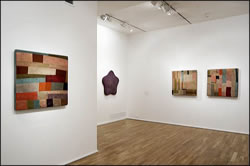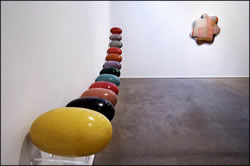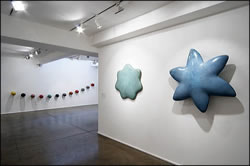|
 Installation View Installation View
 Installation View Installation View
 Installation View Installation View
|
|
Muirne Kate Dineen | colourwallah
21 Nov 2007 - 31 Jan 2008
Kate Dineen is the only woman in the world to have mastered the ancient art of 'araash' or, as it's known in English, Jaupuri fresco painting. Once the livelihood of a caste of masons from Rajasthan, this incredibly physical building technique has only ever been a man's game - a skill passed from father to son over hundreds of years. It is a dying art in India but in the hands of Kate Dineen at least, it is very much alive and her story is an extraordinary one.
Though acutely loyal to the technique, Dineen has developed her own vocabulary with araash, reinterpreting it within a new contemporary context. She creates simple sculptural forms which interface somewhere between sculpture and painting, most of which hang on the wall, although some can be floor-sited. ‘colourwallah’ is a collection of solid stone block pieces, with the surface built from a patchwork of colours, as depicted above. Also showing are highly simplistic, almost amoebic shaped pieces, based on flower shapes. Colour inspiration comes not only from the Indian subcontinent but also from western artists such as Mark Rothko and Yves Klein.
Kate's teenage fascination with the frescoes of Jaipur led her to seek out the only surviving master of the craft, the late Gyarsilal Varma, to learn how to create them. Initially, he was indifferent to her interest (why would a young woman from England be interested?) but, in 1988, she won a Commonwealth/British Council Scholarship to study with Gyarsilal and she became his apprentice. The technique involved in araash requires hard, physical labour. Brick dust, sand and lime are ground up to form the base of the fresco, over which more than twenty layers of ground marble dust, slaked lime and pigment (like an aggregate cement mix) are built into a solid block of coloured stone. These layers are reground three times each with the final set of nine layers burnished with an agate stone to achieve the refined and intensely coloured surface. The final surface is sealed with freshly ground coconut oil. It is this highly polished state that gives it its name – araash means “reflection” in the Marwadi language.
The famous Makrana marble quarry outside Jaipur, generated the marble dust which was recycled as the basic material for use in the araash process. The method was employed by stonemasons to achieve a fine and durable surface to finish a building. They adorn many of the buildings in Jaipur, notably the Amber Palace and ‘Hawamahal’ - the Palace of Winds, as well of the houses of rich maharajas.
Kate Dineen has collaborated with architects Will Alsop and Bijoy Jain at ‘Studio Mumbai’ on site-specific installations in both London and India; she has worked with the High Street chain, Monsoon, and installed her frescoes in shops all over the world. She has also had solo exhibitions in New York, Zurich and Geneva and this is her fourth show at Robert Sandelson in London.
|